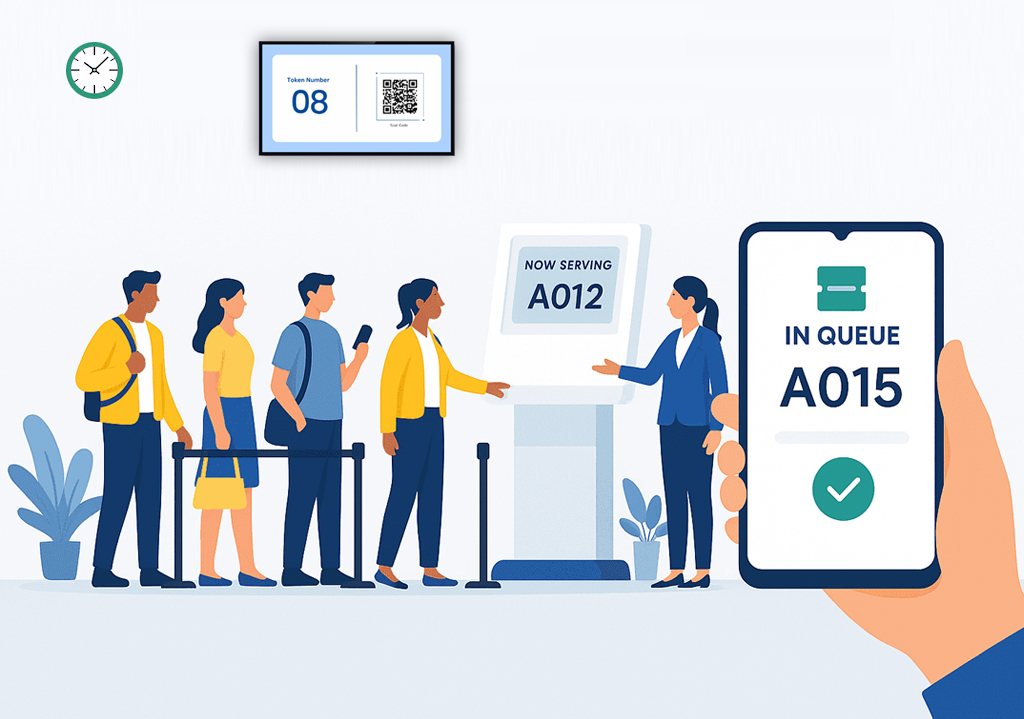 Case Study
Case Study
Smart-Q Digital
Queue Management for RTOs, Odisha
The Regional Transport Offices (RTOs) in Odisha manage thousands of daily visitors
for services like driving license issuance, vehicle registration, permits, tax payments, and grievance redressal.
To improve service efficiency and reduce overcrowding, Suyog Computech implemented Smart-Q,
an intelligent queue management system designed to bring transparency, discipline,
and convenience into the citizen service experience.
and create fast, organized, and citizen-first RTOs.
Making RTO Services Faster & Smarter
Smart-Q was implemented with clear goals
Digitize queue
Real-time queue visibility at counters
Reduce waiting time
Ctizen through automated tokening

Enhanced Monitoring
Administrators for operations centrally

Enhanced transparency
Fairness to the service process
The Challenge
Long Queues | Manual Tokening | Citizen Dissatisfaction
RTOs previously relied on manual processes to manage crowd flow
which created multiple challenges
Crowded waiting halls
Unmanaged queues leading
to long waiting times
Manual token slips
Leading to confusion
and delays
Limited oversight
For administrators on
service load and performance
A digital solution was essential to streamline operations & deliver a transparent, organized, and predictable service experience.
Strategic Solution Framework
We developed a comprehensive approach that addressed both immediate concerns and long-term scalability needs.
User Research & Analytics
Conducted extensive user interviews and analyzed behavioral data to understand pain points
Strategic UX Redesign
Redesigned key user journeys with focus on conversion optimization and user experience
Agile Development
Implemented iterative development process with regular testing and optimization
Intelligent Queue Management System
Smart-Q is a fully digital system that manages crowd flow from the moment a citizen enters the RTO to the completion of their service
For license, registration, permits,
tax, and other services
Category-Based Queueing
For license, registration, permits, tax, and other services
For officers to track load,
performance, and pending queues
Real-Time Dashboards
For officers to track load, performance, and pending queues
Display Screens
Showing live token status and
counter allocation
Smart Routing
To assign citizens to the
right counter based on service type
Alerts & Notifications
To guide citizens
during their service flow
Implementation Approach | Smooth Rollout Across RTOs
Step-by-step deployment ensuring consistent RTO operations
- Requirement Study – Understanding service flow, crowd patterns, and peak-hour challenges
- System Design – Mapping RTO processes into a digital token and counter workflow
- Deployment – Setting up kiosks, display screens, networks, and the Smart-Q backend
- Training – Hands-on training for counter staff, administrators, and officers
- Go-Live & Monitoring – Continuous support, performance optimization, and updates

Functional Highlights
Designed for High-Crowd Government Offices
Digital Token System
For all RTO services
Multi-Counter Integration
Multi-counter RTO setup for faster processing
Live Display Screens
Real-time information on digital display screens.
Admin Dashboard
For real-time operational insights
Service History & Analytics
Dynamic displays for real-time service status
Scalable Architecture
For future service additions
Special Category Priority Handling
Dedicated Priority Support for Special Groups
Efficiency | Transparency | Faster Service
The implementation of solution delivered measurable benefits:
40–50% reduction
In waiting time during peak periods
Improved citizen satisfaction
Due to transparency and predictability
Higher staff efficiency
With reduced manual coordination
Real-time monitoring
Enabling better decision-making for officers



